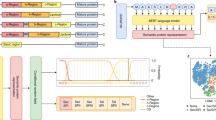Abstract
We examine using a Support Vector Machine to predict secretory signal peptides. We predict signal peptides for both prokaryotic and eukaryotic signal organisms. Signalling peptides versus non-signaling peptides as well as cleavage sites were predicted from a sequence of amino acids. Two types of kernels (each corresponding to different metrics) were used: hamming distance, a distance based upon the percent accepted mutation (PAM) score trained on the same signal peptide data.
Access this chapter
Tax calculation will be finalised at checkout
Purchases are for personal use only
Preview
Unable to display preview. Download preview PDF.
Similar content being viewed by others
References
Nielsen, H., Brunak. S., von Heijne, G., Protein Engineering, vol. 12, no. 1, pp. 3–9, 1999.
Baldi, P., Brunak, S., Bioinformatics The Machine Learning Approach, M. I. T. Press, Cambridge, MA, 1999.
Nielsen, H., Engelbrecht, J., Brunak. S., von Heijne, G., Protein Engineering, vol. 10, no. 1, pp. 1–6, 1997.
V. Vapnik, Statistical Learning Theory, J. Wiley, 1998.
Jaakkola, T. and Haussler, D., Exploiting Generative Models in Discriminative Classifiers, NIPS 11, Morgan Kauffmann, 1998.
Bairoch, A. and Boeckmann, B., Nucleic Acids Research, 22, pp. 3578–3580.
Schwartz, R. M. and Dayhoff, M. O., Atlas of Protein Sequence and Structure, pp. 353–358, 1979.
Chapelle, O., Vapnik, V., Bousquet, O., Mukherjee, S. Choosing Many Kernel Parameters for Support Vector Machines, Machine Learning, 2002.
Tikhonov, A. N. and Arsenin, V. Y., Solutions of Ill-Posed Problems, W. H. Winston, Washington D. C., 1977.
Author information
Authors and Affiliations
Editor information
Editors and Affiliations
Rights and permissions
Copyright information
© 2002 Springer-Verlag Berlin Heidelberg
About this paper
Cite this paper
Mukherjee, N., Mukherjee, S. (2002). Predicting Signal Peptides with Support Vector Machines. In: Lee, SW., Verri, A. (eds) Pattern Recognition with Support Vector Machines. SVM 2002. Lecture Notes in Computer Science, vol 2388. Springer, Berlin, Heidelberg. https://doi.org/10.1007/3-540-45665-1_1
Download citation
DOI: https://doi.org/10.1007/3-540-45665-1_1
Published:
Publisher Name: Springer, Berlin, Heidelberg
Print ISBN: 978-3-540-44016-1
Online ISBN: 978-3-540-45665-0
eBook Packages: Springer Book Archive




